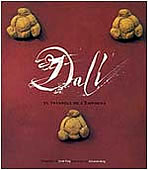September 2003
DALÍ: THE EMPORDÀ TRIANGLE
Photography by Jordi Puig with text by Sebastià Roig
Foreword by Montse Aguer, Commissionner for the Dalí Year and Director of the Centre for Dalinian Studies.
Published by Triangle Postals and the Fundació Gala - Salvador Dalí in six languages: Catalan, Spanish, French, English, Italian and German.
This book is a trip through the country of Dalí, through the land where he grew up and the landscapes that inspired him. A festive stroll around Cadaqués, Figueres and Púbol, with a visit included to the Dalí Theatre-Museum and the artist’s secret refuges.
The author of the foreword describes the book in the following terms: It is difficult to understand the personality and work of Salvador Dalí without knowing the three Dalinian centres par excellence. The first one, the house of Port Lligat, is the essence. In this house Dalí lived, created and transformed, penetrated by scenery, light and isolation, which conditioned, influenced and inspired him. Dalí explains about Port Lligat: “It was there I learnt to become poor, to limit and file down my thoughts so that they would acquire the sharpness of an axe, where blood tasted of blood and honey of honey. A life that was hard, without metaphor or wine, a life with the light of eternity”.
The castle of Púbol, the fortress and refuge for Gala, the visible wife, is more austere. There are no accumulations, it is more severe and mysterious and it fascinates us. Here we discover a mature Dalí who pays homage to Gala, his muse, and he provides her with a space where she can be free. For Dalí, it would be a place for reflection, for thinking about illness and death. Nevertheless, the castle is bright, full of symbolism and small ironies that speak to us of a unique couple.
The Dalí Theatre-Museum of Figueres, opened on the 28th of September 1974, is the accumulation, the plenitude and the totality. It is the theatre of the memory, full of allusions to the artist’s life and work, extremely localised and universal at the same time. As the artist himself states, “The Museum should not be considered as a museum, it is a gigantic surrealist object, everything inside is coherent, there is nothing that escapes from the webs of my understanding”.
Port Lligat, Púbol and Figueres, three angles of a creative idiosyncrasy, that approach us, show us and explain to us an internationally renowned artist with strong local roots. This book brings us closer to the painter and guides us along some routes that are essential for understanding Dalí’s work as a whole. The light, colour, irony and the people ... the Empordà region, accompany him and us on this fascinating journey.






